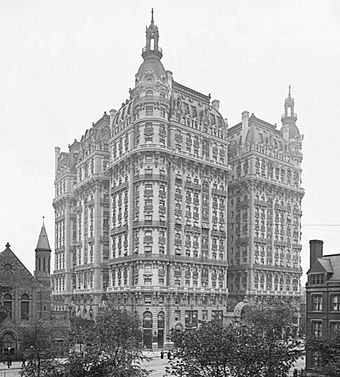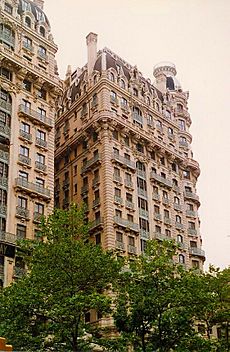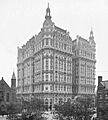The Ansonia facts for kids
|
Ansonia Hotel
|
|

The Ansonia Hotel on Broadway at the intersection with Amsterdam Avenue (image from 1905)
|
|
| Location | 2101–2119 Broadway, New York, New York |
|---|---|
| Area | less than one acre |
| Built | 1899-1904 |
| Architect | Duboy, Paul E.M. |
| Architectural style | Beaux Arts |
| NRHP reference No. | 80002665 |
Quick facts for kids Significant dates |
|
| Added to NRHP | January 10, 1980 |
The Ansonia is a famous building in New York City. It is located on the Upper West Side of Manhattan, at 2109 Broadway. This grand building was originally a special kind of hotel called a residential hotel. This meant people lived there for a long time, almost like apartments.
It was built by William Earle Dodge Stokes, who was very rich. He named the building after his grandfather, Anson Greene Phelps. In 1897, Stokes hired a French architect named Paul Emile Duboy to design the most amazing hotel in Manhattan. Stokes even called himself the "architect-in-chief" for the project.
One of the most unusual things about the Ansonia was a small farm on its roof! Stokes had a dream that the hotel could produce its own food. He kept about 500 chickens, ducks, goats, and even a small bear on the roof. There was even a special elevator just for cows to reach the roof. Every day, hotel staff delivered fresh eggs to the residents for free. Any extra eggs were sold cheaply in the basement. However, the city government did not like this idea, and the rooftop farm was closed in 1907.
Contents
History of the Ansonia
The Ansonia was built between 1899 and 1904. It was the largest residential hotel of its time. It was also the first hotel in New York to have air conditioning.
Luxurious Living at the Ansonia
The apartments inside the Ansonia were very fancy. They had many bedrooms, living rooms, and even libraries. Some rooms were round or oval. Residents enjoyed high ceilings and beautiful bay windows with views of Broadway. The building had three thousand rooms in total.
People could rent suites of different sizes. Some large suites cost $14,000 a year, which would be over $400,000 today! Smaller apartments did not have their own kitchens. Instead, there was a main kitchen for the whole hotel. Each floor also had smaller kitchens. This allowed residents to have professional chefs cook for them right in their own apartments.
Besides the apartments, the Ansonia had many other cool features. It had tearooms, restaurants, and a huge ballroom. There were even Turkish baths for relaxation. In the lobby, there was a fountain with live seals swimming in it!
Building Design and Changes
The Ansonia has an eighteen-story steel-frame structure. Its outside is decorated in the Beaux-Art style. This style is known for being grand and fancy, often seen in Paris. The building also has a special mansard roof, which is a sloped roof with windows. You can see round towers or turrets on the corners of the building. Inside, a grand staircase goes all the way up to a domed skylight.
During World War II, the copper decorations on the outside of the building were taken off. The copper was melted down to help with the war effort.
Famous Residents and Modern Use
Many famous people have lived at the Ansonia. These include:
- Baseball legend Babe Ruth
- Writer Theodore Dreiser
- Religious leader `Abdu'l-Bahá
- Nobel Prize winner Isaac Bashevis Singer
- Conductor Arturo Toscanini
- Composer Igor Stravinsky
- Fashion designer Koos Van Den Akker
- Opera singer Enrico Caruso
By the middle of the 1900s, many of the large apartments were divided into smaller studios. However, they still kept their original fancy details. In the 1960s, there was a plan to tear down the building. But many artists and musicians who lived there fought to save it, and they succeeded!
In 1980, the Ansonia was added to the National Register of Historic Places. This means it is a very important historical building. In 1992, the Ansonia changed from a hotel to a condominium apartment building. Today, it has 430 apartments. Many smaller apartments have been combined to create large, grand homes again.
The Ansonia is also home to part of the American Musical and Dramatic Academy. This is a school where students learn about music and acting.
Images for kids
See also
 In Spanish: The Ansonia para niños
In Spanish: The Ansonia para niños






